Exploring the Thrills and Techniques of Wake Skating
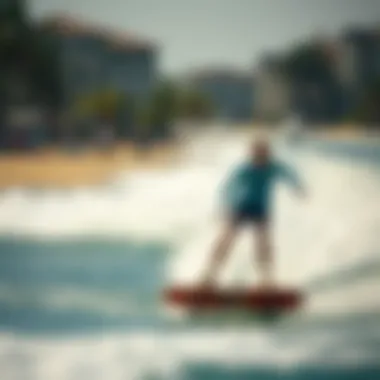
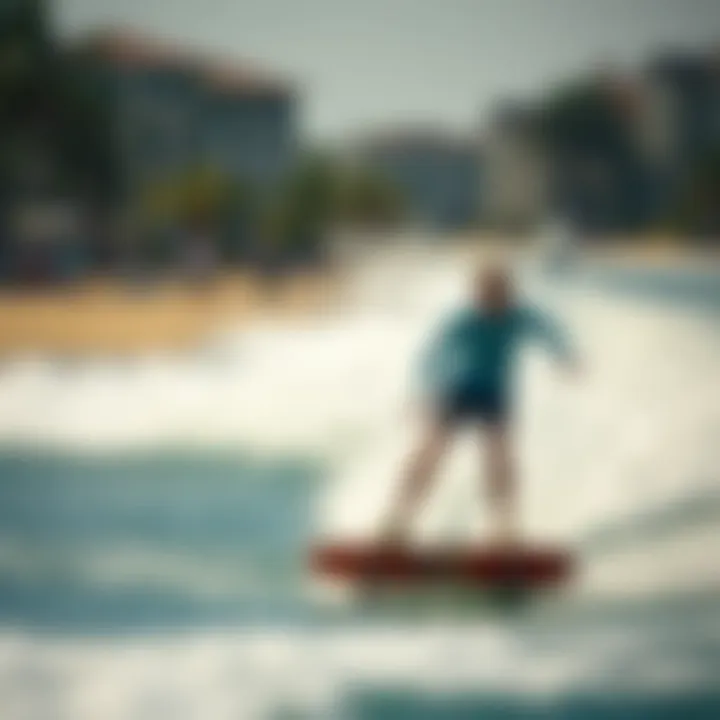
Intro
Wake skating stands at the crossroads of skateboarding and wakeboarding, bringing a refreshing twist to how we enjoy water sports. This sport, which takes place behind a boat on a surfboard-like contraption, has gained popularity among thrill-seekers and water enthusiasts alike. Unlike wakeboarding, where riders are harnessed to a board with boots, wake skate riders enjoy the freedom of riding barefoot, fostering a closer connection to the water.
The essence of wake skating lies in its unique blend of techniques and skills borrowed from both skateboarding and wakeboarding. With an emphasis on fluid motion and balance, it transforms the water into a canvas where surfers express creative freedom.
As we dive deeper into the world of wake skating, this article will cover its origins, key techniques to master, essential equipment needed, and the vibrant culture that envelopes the sport. Whether you're an experienced water sport lover or a newcomer eager to ride the waves, there is something here for everyone.
Discovering the right gear, understanding advanced maneuvers, or even catching your first wave will be discussed thoroughly, offering insights that blend enjoyment with practicality. In this way, we aim to equip our readers with the knowledge needed to transition smoothly into this dynamic world.
The Essence of Wake Skating
Understanding the essence of wake skating is like peering into its very soul. It's not just a sport; it's a lifestyle that intertwines creativity, athleticism, and a love for water. The blend of skateboarding and wakeboarding creates a unique platform where riders express themselves while floating over water. This section sheds light on its significance, framed around its elements, benefits, and considerations that every enthusiast ought to ponder.
Defining Wake Skating
So, what exactly is wake skating? Simply put, wake skating combines aspects of both skateboarding and wakeboarding on the water. Riders use a skateboard-like board without any foot bindings, allowing for a free and loose riding style. The absence of bindings is a defining feature, as it enables the rider to perform tricks, flips, and spins with an unparalleled sense of liberation.
This sport requires a keen sense of balance and control while navigating across the boat’s wake. Riders often find themselves experimenting with tricks, from the simpler ones like ollies to more advanced maneuvers like shuvits. Ultimately, the appeal of wake skating lies in this ability to adapt and innovate on the water.
Historical Background
To better appreciate the present, one must understand the past. Wake skating traces its roots back to the early 2000s, but it draws heavily from other water sports. The first pioneers, like Terry E., were inspired by skateboarding, initially experimenting behind boats with traditional skateboards. This was the spark that ignited a new realm of sports where the water served not only as a medium but also as a canvas for creativity.
The evolution continued as the boards became more specialized, with increased flotation and better materials to enhance performance. While wakeboarding was burgeoning, wake skating carved out its niche by relying on style, technique, and innovation rather than sheer speed or height.
As wake skating gained traction, it fostered a vibrant community passionate about sharing their experiences. Competitions began popping up, and culture blossomed around the sport with enthusiasts encouraging one another to push limits and explore new tricks.
In summary, the essence of wake skating is deeply rooted in its artistic expression, community spirit, and the thrill of riding freely on water. By grasping its core components, riders can better appreciate not only the mechanics of wake skating but also its vibrant culture.
Core Techniques for Success
Understanding the core techniques in wake skating is like having a well-organized toolbox; without the right tools, it's tough to get your project off the ground. Mastering these techniques not only enhances your skills but also elevates your overall experience on the water. From basic board control to advanced tricks, the knowledge you gain here will lay the foundation for your success in the sport.
Fundamental Skills
Before you can flip and spin like pros do, it's crucial to nail down the fundamental skills. These include stance, balance, and edge control. A proper stance—feet shoulder-width apart with knees slightly bent—ensures you maintain balance.
Another element is edge control. This refers to how you position and shift your weight on the board. Learning to shift your weight smoothly while edging into turns will make your ride feel fluid and controlled. Beginners often struggle with balance. Here are some focused tips to improve:
- Practice on Land: Use a skateboard or balance board to get a feel for keeping your balance.
- Slow It Down: Don’t rush your moves in the water; mastering each element at a slow pace can work wonders.
- Watch and Learn: Observing experienced riders can provide insights into effective body mechanics.
By honing these skills, you create a solid launchpad for more complex tricks down the line.
Advanced Maneuvers
Once you’ve built a sturdy foundation, it’s time to venture into advanced maneuvers. This is where the adrenaline kicks in. Tricks like kickflips, frontside 180s, and shuvits take precise timing, body control, and confidence.
For instance, in a kickflip, the rider must snap the board up while simultaneously flicking their foot to add the spin. Here’s how you can nail these tricks:
- Visualize: Picture every movement before you attempt it.
- Break It Down: Practice each component of the trick separately, then combine them gradually.
- Commit: Doubt leads to hesitation, which could result in wipeouts. Trust your instincts.
Even the most seasoned wake skaters had to conquer these hurdles, so don't be discouraged if progress feels slow. Every great rider once stood on shaky legs.
Safety Precautions
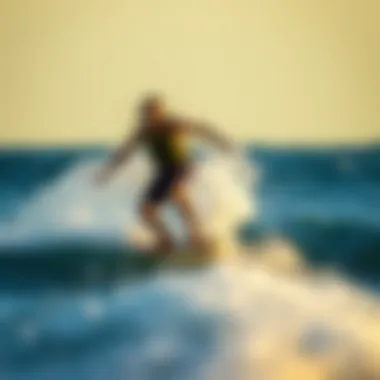
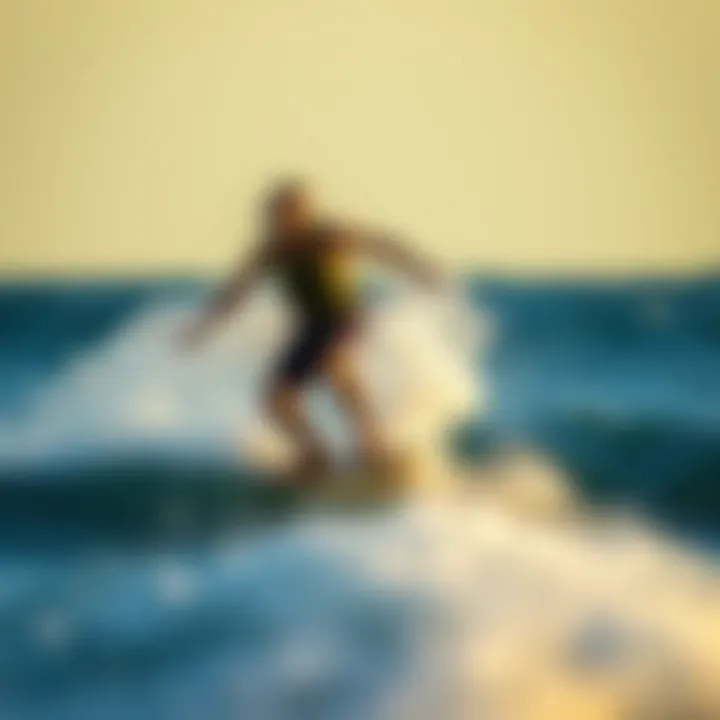
While the thrills of wake skating capture the excitement of the sport, safety must always be top of mind. Before you hit the water, equip yourself with essential safety gear. Wearing a life jacket is non-negotiable; it can mean the difference between a fun day and a trip to the hospital.
Here’s a quick checklist for your safety:
- Use a Helmet: Not just for biking, a helmet can protect your noggin during falls.
- Check the Water Conditions: Always assess the weather and water state before getting in.
- Know Your Limits: Steer clear of attempting tricks that are beyond your current skill level.
"Safety is a state of mind. Be aware, ride smart."
Ultimately, being mindful of safety allows you to focus on enjoyment and progression without the looming threat of injury. Prioritizing safety fosters an environment for growth and creativity in wake skating.
Once these core techniques are mastered, the journey into the dynamic world of wake skating can continue. When the fundamentals are locked in, your season will be filled with exhilarating progress and plenty of unforgettable moments on the water.
Essential Equipment Overview
The success and enjoyment of wake skating greatly hinge on the equipment choices one makes. It's a world where the right gear can mean the difference between a thrilling day on the water and one filled with frustration due to equipment failures. This section breaks down the essential elements of wake skating gear, guiding enthusiasts towards smarter choices for their adventures on the water.
Choosing the Right Skateboard
Selecting a skateboard for wake skating is akin to finding the right pair of shoes for running—a mismatch can lead to discomfort and poor performance. The board's design plays a crucial role. Generally, a wake skate will be shorter and wider compared to a skateboard, providing better flotation and balance over water.
When choosing, look for these key points:
- Material: Many boards are made from a lightweight composite or wood, with each offering different ride characteristics. Flexibility in material directly influences how the board performs during tricks and stability.
- Size: A board that suits your height, weight, and skill level can enhance your experience. A larger board can help beginners with balance, whereas more experienced riders might prefer a narrower design for tricks.
- Shape: Some boards come with features like kicktails for increased responsiveness during jumps. Check what fits your style best.
An anticipated question might be: "How much should I invest in my board?" Prices can range from affordable to premium, depending on the brand and features. It might be wiser to settle for a mid-range board that offers decent durability and performance instead of splurging on a high-end model right off the bat.
Bindings and Footwear
Next up are bindings and footwear, elements that often get overlooked but are essential to a good ride. Bindings keep your feet securely attached to the board, providing both comfort and control. When shopping, consider:
- Fit: It’s vital that bindings are snug but not overly tight to prevent injuries. Many brands offer adjustable bindings to accommodate various foot sizes.
- Type: You’ll come across closed-toe or open-toe bindings. Closed-toe bindings assist with more direct connection and responsiveness, while open-toe options allow for easier adjustments and comfort.
- Material: Look for durable materials that provide support without compromising flexibility.
Footwear can also play a role. While most wake skaters opt to go bare-footed for a better grip, having a good pair of water shoes can protect your feet against sharp objects in the water or on the platform. Choose wisely!
Ropes and Handles
Ropes and handles might seem like simple tools, but their quality and design can significantly affect your performance on the water. Here are some aspects to consider:
- Length of the Rope: Ropes typically range from 60 to 75 feet. A longer rope provides more room for tricks and jumps but requires a bit more experience to handle effectively.
- Handle Design: A comfortable grip is essential. Handles come in padded options that prevent slipping and add comfort during long sessions. Check the material for durability against wear and tear.
- Weight Capacity: Ensure that the rope can handle the weight of riders and any additional stress during tricks.
In summary, investing in high-quality ropes and handles can enhance the overall wake skating experience.
Important Note: Prioritize quality over price where possible. Reliable gear can boost performance levels and increase enjoyment.
To further enrich the wake skating experience, consider learning from established communities. Websites such as Reddit or even Wikipedia can provide additional insights and recommendations.
Understanding the nuances of your equipment is a fundamental step towards mastering wake skating. Choosing the right skateboard, bindings, and ropes will not only improve your performance but also contribute to a more enjoyable and safer experience on the water.
Wake Skating vs. Other Water Sports
When it comes to water sports, the variety is as vast as the ocean itself. Wake skating holds its own unique position among various activities like wakeboarding and surfing, each offering distinct experiences and challenges. In this section, we’ll delve into the key aspects that differentiate wake skating from its counterparts, highlighting its nuances, benefits, and what makes it a delightful pursuit for enthusiasts.
Comparison with Wakeboarding
One cannot discuss wake skating without mentioning wakeboarding. Both sports share a similar foundational core, yet they diverge in significant ways that cater to different experiences. While wakeboarding involves strapping your feet into a board, wake skating lets riders feel a greater sense of freedom by riding without bindings. This subtle distinction leads to a change in physical dynamics.
Key Differences
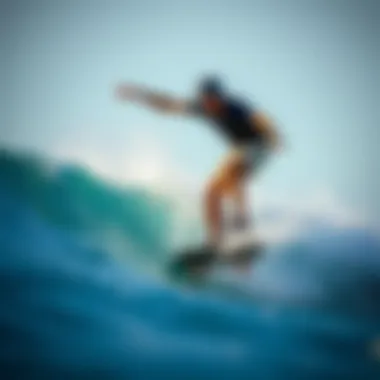
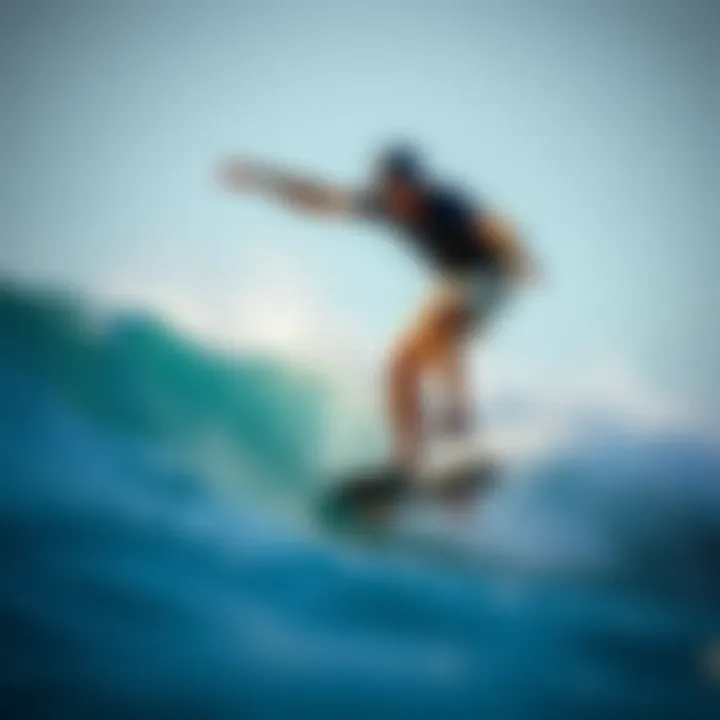
- Bindings vs. Non-bindings: As mentioned earlier, the major difference is the binding system. Unlike wakeboarders, who are confined by their straps, wake skaters enjoy a more fluid ride, allowing for a more spontaneous style and tricks.
- Sensation and Technique: One of the most fascinating aspects of wake skating is the freedom it affords. Riders can often leverage their body weight to execute maneuvers, making it almost akin to skateboarding on water, while wakeboarding focuses more on the mechanical leveraging of the wake created by the boat.
- Skill Development: Both require a firm foundation on water, but the approaches vary. Wakeboarding might emphasize learning tricks that involve the wake itself, while wake skating prioritizes balance and agility, with more emphasis on land-style tricks that can be performed on flat water.
Some enthusiasts dabble in both sports, enjoying the versatility each presents; yet, as many skilled riders assert, each sport cultivates a distinct sense of style and skill set. This cultural and technical divergence is what makes wake skating an alluring option for those seeking an alternate thrill on water.
Contrasts with Surfing
Though surfing and wake skating might seem worlds apart, interesting parallels and contrasts arise between the two, painting a fuller picture of wake skating's appeal. Surfing revolves around the ocean's natural waves, whereas wake skating is anchored in the context created by a boat's wake.
Vibrant Differences
- Wave Dependency: Surfing demands a direct reliance on the ocean’s whims. In contrast, wake skating allows enthusiasts to create their own ride, consistently boarding without the need for ideal weather conditions. This aspect opens avenues for year-round adventure, making it attractive in regions where ocean access may be limited!
- Trick Dynamics: Wake skaters often adapt tricks from other sports, like skateboarding, honing skills that translate seamlessly between land and water. Surfing tends to focus on fluidity and wave manipulation, demanding a nuanced balance with the ocean’s motion and energy.
- Atmosphere and Communities: The culture surrounding each sport also varies. Surfing has its roots in a deep cultural history and tradition, often connected to specific locales and ocean conservation movements. Wake skating fosters a more laid-back community atmosphere with a focus on fun, innovation, and collaboration among enthusiasts who often share tips and tricks in diverse online communities, such as those found on Reddit.
“Wake skating embodies that spirit of experimentation and creativity, providing a playground for those ready to explore.”
All in all, engaging in wake skating means embracing a world where innovation thrives. As riders adapt and reinvent techniques, they continue to contribute to the sport's vibrant evolution. Understanding the distinctions and nuances among wake skating, wakeboarding, and surfing not only informs one’s engagement but also deepens the appreciation for each sport's unique attributes. The diverse environment in which wake skating exists allows for varied experiences, making it a thrilling choice for both amateurs and pros. It truly caters to a breadth of enthusiasts, each finding their niche in the thrilling world of water sports.
Explore more about wake skating culture and techniques at Wikipedia, and engage with the community on Reddit or Facebook.
The Community and Culture of Wake Skating
Wake skating is more than just a sport; it's a vibrant community that fosters connections among enthusiasts. The culture surrounding wake skating blends elements from various backgrounds, making it an enriching experience for individuals from different walks of life. This section will explore the essence of this community, highlighting influential figures, notable events, and the online resources that knit the fabric of wake skating culture.
Influential Figures in the Sport
While many ride the wake, a handful of individuals truly shape the trajectory of wake skating. Pioneers like Brian Grubb and Chad Sharpe have not only pushed the limits of what’s possible on a wakeskate but also inspired countless others. Grubb, for instance, is renowned for his inventive tricks and approach to riding, which has made a significant impact on how the sport is perceived.
Aside from these established names, many emerging talents contribute to the community’s growth. Young riders often pick up the sport after seeing their idol's videos online. These figures often share their tips and experiences on social media. It creates a cycle of encouragement within the community, inspiring newcomers every day.
Moreover, these influencers often collaborate on projects or contests. A collective spirit emerges when they come together, showcasing their unique skills and sharing their journeys, thus enriching the community further.
Events and Competitions
Events and competitions provide vital platforms for wake skaters to showcase their skills and connect with others in the field. Local contests, such as the King of Wake, have blossomed into more significant annual events attracting hundreds of participants and viewers alike. These gatherings cultivate camaraderie and allow riders to learn from one another, all while witnessing epic routines and jaw-dropping tricks.
Furthermore, many riders attend these events not just to compete but also to socialize and exchange tips on techniques and gear. The thrill of competition is enhanced by the presence of spectators, family, and friends who cheer for their favorite riders, creating an electric atmosphere.
In addition to competitive events, there are fun-based gatherings like the Summer Wake Fest that promote relaxation alongside the competition. These festivals often feature live music, workshops, and even opportunities to try out the latest gear from top brands. Being part of such events strengthens community bonds and makes the experience a celebration of wake skating culture.
Online Communities and Resources
In today’s digital age, online platforms play a crucial role in connecting wake skating enthusiasts. Websites like Reddit and Facebook host numerous groups where members share tips, tricks, and footage of their rides. Engaging in these discussions not only helps them refine their skills but also creates a sense of belonging among global enthusiasts.
Key Online Resources for Wake Skating
- Reddit: Subreddits like r/Wakeskating foster discussions and community engagement.
- Facebook Groups: Numerous pages exist for both seasoned riders and newcomers, providing a space to ask questions and share experiences.
- YouTube: A treasure trove of tutorials and inspirational videos that showcase skills and progressions.
- Industry Websites: Sites like wakeworld.com offer insights into the latest gear, events, and news in the wake skating world.
"The Internet has bridged gaps between geographical divides, enabling riders to connect with each other like never before."
In summary, the community and culture of wake skating are defined by the interactions among its members, the inspirational figures who lead the way, and the dynamic events that solidify the bonds. Understanding this aspect gives depth to the experience of wake skating, making it not just a hobby or sport, but a shared journey.
Traveling for Wake Skating
Traveling for wake skating is not just about finding the perfect spot; it's about immersing oneself in a culture that appreciates the rush of gliding over water while being propelled by a boat. Each location offers its flavor, from various weather patterns to unique water conditions, which are essential to understand before you pack your gear. Knowing where to head can greatly enhance your experience and provide opportunities to learn from local enthusiasts, making the journey more than just a vacation but a leap into a vibrant community.
Here's a closer look at what makes the destinations appealing and what you need to consider when planning your wake skating escapade.
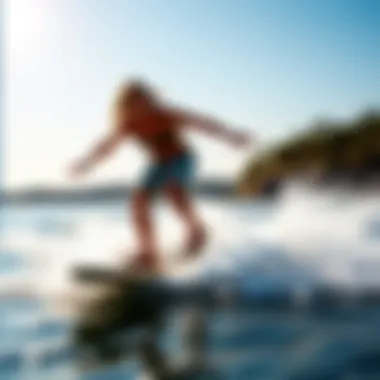
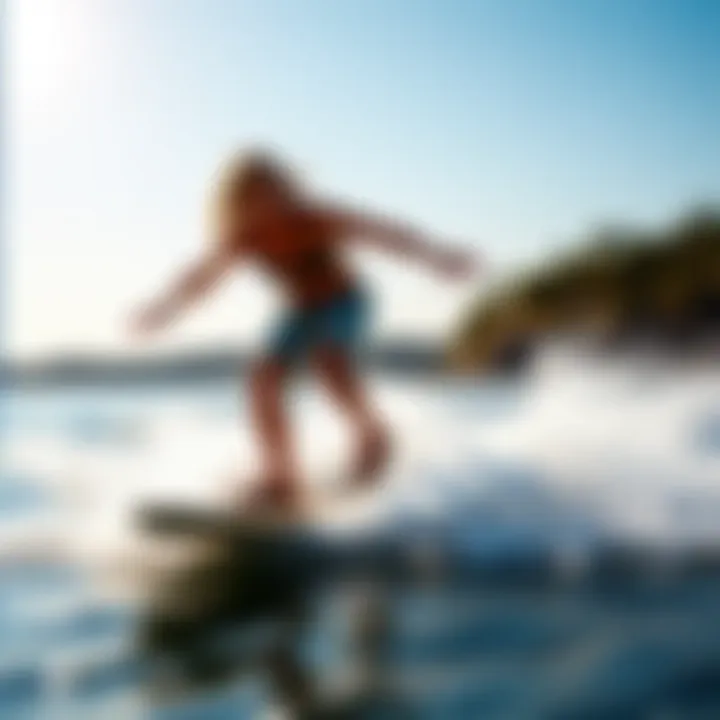
"The voyage counts as much as the destination, especially when seeking that perfect wave or glide."
Best Locations Worldwide
When considering the best places for wake skating, it’s crucial to factor in not just the water conditions but also accessibility and local culture. Here’s a spotlight on some prime locations, each with its unique charm:
- Lake Powell, USA: Nestled among stunning red rock formations, it offers calm waters and ample space to practice complex maneuvers. This location is a favorite among both amateurs and seasoned pros.
- Cairns, Australia: Known for its tropical climate and beautiful lakes, Cairns provides not only warm waters all year but also a chance to connect with other water sports enthusiasts.
- Lago di Garda, Italy: This picturesque lake is famous for its wind conditions, making it ideal for wake skating while providing a stunning backdrop of the Italian Alps.
- Ibiza, Spain: Besides its nightlife, Ibiza has beautiful coves and spots where wake skating is thriving. Local clubs often host events that can be fun to participate in.
- San Diego, USA: With diverse water conditions and a vibrant skate scene, San Diego is perfect for varying skill levels and is often less crowded than other hotspots.
- Tokyo Bay, Japan: As wake skating grows in East Asia, Tokyo Bay is emerging as a unique location where the sport blends with culture and modernity.
Eco-Friendly Practices
As wake skating gains popularity, it's imperative to consider its environmental impact. Being mindful of eco-friendly practices helps preserve these amazing locations for future generations. Here are some guidelines to stay responsible while enjoying wake skating:
- Choose Eco-Friendly Gear: Look for products made from sustainable materials. Some companies focus on creating equipment that lessens environmental impact.
- Stay in Designated Areas: Respecting local ecosystems is vital. Stick to marked boat paths and avoid sensitive marine areas to minimize disturbances.
- Dispose of Trash Properly: Bring a trash bag along to collect your waste. This simple act goes a long way in keeping natural surroundings pristine.
- Educate Yourself: Learn about the ecosystems you visit. Understanding the local marine life and habitat can enhance your experience while fostering appreciation for nature.
- Carpool or Use Public Transport: Whenever possible, reduce your carbon footprint by riding together with fellow wake skaters or using public transportation.
As wake skating continues to evolve, engaging with diverse environments and cultures can make for an enriching journey. The thrill of anticipation, the joy of new discoveries, and the shared love for the sport unite enthusiasts regardless of where they come from.
Future Trends in Wake Skating
As we look ahead into the evolving landscape of wake skating, it becomes evident that several key trends are emerging. These trends are shaping how enthusiasts participate in this exhilarating sport, as well as influencing the broader surfboarding culture. The importance of discussing these future trends lies in recognizing the dynamic nature of wake skating and its adaptability to technological advancements and environmental considerations.
Technological Innovations
Technology has always been a game-changer in sports, and wake skating is no different. With the rise of smart gear and advanced materials, wake skaters can expect to see improvements that enhance both performance and safety. One significant trend is the development of boards made from lighter and more durable materials. These innovations allow skaters to perform tricks that were once thought impossible, while also reducing the risk of injury.
Additionally, the integration of smart technology into equipment is becoming more prominent. Imagine wearing a suit equipped with sensors that track your movements or a board with built-in gyroscopes to help perfect your landings. These innovations not only aid in skill development but also offer valuable performance metrics, making it easier for both amateurs and pros to gauge their progress.
Moreover, manufacturers are focusing on creating eco-friendly products. Biodegradable materials and processes that minimize waste are now key considerations for brands. For instance, a company might opt for sustainable composites rather than traditional plastic, harmonizing performance with environmental responsibility.
"Innovation in wake skating shouldn't just focus on performance but also consider our impact on the environment."
Environmental Considerations
As the wake skating community grows, so does the responsibility to protect natural waterways. Enthusiasts and industry players are recognizing the importance of preserving the environments in which they ride. Environmental considerations have become a focal point, with many organizations advocating for sustainable practices.
One impactful trend is the push for cleaner recreational areas. Many wake skating spots are susceptible to pollution and environmental degradation. Local advocacy groups are rallying to raise awareness about protecting these spaces from harmful practices like littering, oil spills, and chemical runoff from boats.
Furthermore, skaters are now more aware of the need to support eco-friendly boating practices. This includes the shift towards electric boats, which significantly reduce carbon emissions and noise pollution, allowing for a more serene riding experience. Some skaters are even opting for shared boating programs to limit the number of vessels in the water, thereby reducing their environmental footprint.
Lastly, educating new skaters about sustainability continues to grow in importance. Workshops, online courses, and community events aim not just at teaching tricks but also emphasizing the significance of preserving the natural beauty that makes wake skating possible.
In summary, as wake skating moves forward, it intertwines increasingly with both technological advancements and environmental consciousness. Embracing these changes not only enhances the sport but also ensures that future generations can enjoy the thrill of wake skating without compromising the health of our waterways.
Closure and Final Thoughts
In wrapping up our deep dive into the world of wake skating, it’s clear that this sport offers unparalleled excitement and a unique blend of skills from both skateboarding and wakeboarding. However, it isn't just about the adrenaline rush; there’s a profound sense of community alongside creativity within the sport that draws enthusiasts in. The diverse techniques and styles allow every rider to express their individuality on the water, making wake skating an appealing activity for many.
The Appeal of Wake Skating
For those who have yet to experience wake skating, the allure lies in several key factors:
- Accessibility: Unlike traditional wakeboarding, wake skating does not necessitate bulky gear. Just a skateboard-like deck is enough, making it approachable for newcomers.
- Versatility: Whether you’re carving into the water, performing tricks, or simply cruising, it accommodates a wide range of styles. Riders can adapt their maneuvers based on skill level and personal preference, fostering a personalized experience.
- Freedom and Expression: With no bindings to restrict movement, riders can truly connect with their board and the water, facilitating unbridled creativity. This freedom is inviting, often leading to an organic development of skills and style.
The camaraderie found within the community also enhances its appeal. Engaging with fellow riders, sharing tricks, and participating in events can create lasting friendships and a support system for all levels of skaters.
Encouraging Exploration
As we close the chapter on this exploration, it’s vital to encourage aspiring wake skaters to step outside their comfort zone. Don’t let the fear of failure hold you back; each fall on the water is an opportunity to learn and grow. Explore local spots, connect with experienced riders, and, importantly, consider participating in events where you can gain insight and inspiration.
- Seek out diverse locations: Traveling to different lakes or beaches can influence your skating significantly, offering varied conditions that enhance your adaptability.
- Invest in learning: Watching online tutorials, joining workshops, or even engaging with communities on platforms like Reddit can accelerate your learning curve, arming you with valuable insights and skills.
- Share your journey: Documenting your progress can encourage you to keep pushing limits while also inspiring others within your circle.
Ultimately, the beauty of wake skating lies in the adventure it presents—a chance to grow, connect, and explore both personally and within the community. So grab your board, hit the water, and let the journey as a wake skater unfold.
"The road to mastering new skills is like riding on water; it may not always be smooth, but it sure is exhilarating."















